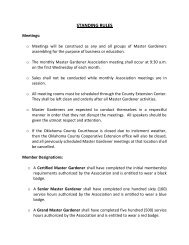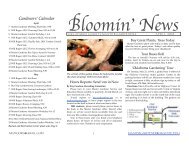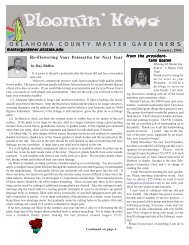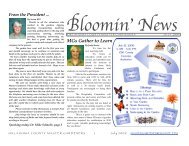Bloomin' News - Oklahoma County Master Gardeners
Bloomin' News - Oklahoma County Master Gardeners
Bloomin' News - Oklahoma County Master Gardeners
You also want an ePaper? Increase the reach of your titles
YUMPU automatically turns print PDFs into web optimized ePapers that Google loves.
Gardener’s Calendar<br />
APRIL<br />
2! Plant Sale preparation, bring donation plants to<br />
! Extension classrooms, 9 to 4:00<br />
3! Plant Sale, Extension Classrooms, 9 to 2:00<br />
4! Meeting; Barry Fox, Greenhouse Manager for<br />
! Horticulture Center speaks; Remnant Plants Sale;<br />
! Craft Sale<br />
11! Garden Work Day, 10 to 2:00<br />
13 ! Plant Sale for MGs, Hort Center Greenhouse, 9 to 3:00<br />
14! Farmers’ Market, 4 th & Portland, 10 to 1:00<br />
14! Garden Work Day, 10 to 2:00<br />
18! Tony’s Tree Plantation, Fairy Garden demo<br />
20 ! Will Rogers Garden Center, Spring Walk, 9:30<br />
24! Learning Lab, 9 to 3:00<br />
25! Garden Work Day, 10 to 2:00<br />
26! Board Meeting, North Classroom, 9:30<br />
28! Farmers’ Market, 4 th & Portland, 10 to 1:00<br />
30 ! Plant Sale preparation, Auditorium, 9 to 4:00<br />
MAY<br />
1! Plant Sale, In Extension auditorium, 9 to 2:00<br />
2! Meeting: Patricia Folley discusses her wildflower<br />
! guide for OK, Books for sale; Plant Remnants Sale<br />
4! Native Landscapes, Will Rogers Gardens<br />
09 ! Garden Work Day, 10 to 2:00<br />
11! Flower Arranging, Will Rogers Gardens<br />
12! Farmers’ Market, 4 th & Portland, 10 to 1:00<br />
12! Garden Work Day, 10 to 2:00<br />
17! Members’ Garden bus tour<br />
19! Festival in the Park, Will Rogers Park, 9 am<br />
20! Board Meeting, North Classroom<br />
23! Garden Work Day, 10 to 2:00<br />
26! Farmers’ Market, 4 th & Portland, 10 to 1:00<br />
Bloomin’ <strong>News</strong><br />
Sign up Today for Excursions, MG Conference<br />
By Kathleen Hardwick, Touring Chair<br />
! Sign up for tours this morning, including trips to Tony’s Tree Plantation, the<br />
Members’ Garden Tour, the Ponca City Herb Festival and the <strong>Oklahoma</strong> <strong>Master</strong><br />
Gardener Conference.<br />
! Tony’s Tree Plantation is a must see! Just opened at 3801 S. Post Road, the 10 acre<br />
garden center welcomes us Wednesday, April 18, with a demonstration on how to<br />
construct a fairy garden. We will tour the grounds which feature koi ponds, bridges,<br />
water features, and a 14,000 square foot greenhouse full of plants to tempt us. Tony is<br />
generously enticing us with a 10% discount, as if we need enticement. PLEASE WEAR<br />
YOUR NAME BADGE to take advantage of the discount. Details available at signup. There<br />
is much to see, but be sure to notice the outdoor pathways, one of which features 101<br />
styles of pavers which change every few feet. Also check out the murals on the walls and<br />
ceiling of the retail shop. This garden center is a showcase of design ideas, plants, pots<br />
and hardscape. !<br />
! The annual Members’ Garden Tour, Thursday, May 17, will be a bus tour, and we<br />
ask again that everyone ride the bus. If you would be willing to host a tour of your own<br />
gardens, please contact me as soon as possible. Bus seats for this tour are $15 which does<br />
not include lunch.<br />
! The Ponca City Herb Festival, Saturday, June 2, at the 10 acre Cann Memorial<br />
Gardens will also be a bus trip. More than 100 vendors from many states bring plants,<br />
primitive birdhouses, yard and garden ornaments, quilts, herbal vinegars and oils,<br />
soaps, candles, etc. Seminars scheduled include Bees in the Landscape, Container<br />
Gardening, Composting, Butterflies & Gardening and Crafting with Gourds. This tour runs<br />
$20, and members pay for their own lunches.<br />
! Our bus trip to the <strong>Oklahoma</strong> <strong>Master</strong> Gardener Conference, Red Dirt Gardening: A<br />
Window into the Future, will be Friday, June 15 in Stillwater. Seats on the bus run $15.<br />
Conference registration is additional. Mail to: Stephanie Larimer, HortLA, OSU, 358 Ag<br />
Hall, Stillwater, OK 74078-6027. For fee and deadline, check: http://<br />
www.hortla.okstate.edu/mg/index.htm<br />
! Allan Storjohann’s keynote address, Be a Smarter Gardener: Watch the Trends, Costs<br />
and Pitfalls of the Garden begins the day. More speakers and topics soon. Happy Touring!<br />
<strong>Oklahoma</strong> <strong>County</strong><br />
<strong>Master</strong> <strong>Gardeners</strong><br />
APRIL 2012<br />
On the Road Again!<br />
Sign up today<br />
For Bus Tours<br />
May 17, $15<br />
Members’ Garden<br />
Bus Tour<br />
MGHOURS@GMAIL.COM 1<br />
MASTERGARDENER@OKSTATE.EDU<br />
•••<br />
June 2, $20<br />
Ponca City Herb Festival<br />
Bus Tour<br />
•••<br />
June 15, $15<br />
<strong>Oklahoma</strong><br />
<strong>Master</strong> Gardener<br />
Conference<br />
Bus TourSeats are<br />
available first to<br />
certified & emeritus<br />
<strong>Master</strong> <strong>Gardeners</strong>.
From the President ...<br />
By Peggy Garrett<br />
What did Will Rogers say? "If you don't like<br />
the weather in <strong>Oklahoma</strong>, wait five minutes and it<br />
will change." That's certainly been true the past few<br />
weeks.<br />
! We had rain, sleet, snow and hail all in one<br />
afternoon, and temperatures in the 70s the next day. How<br />
crazy is that? It's certainly has our garden plants<br />
confused.<br />
! I am so ready to get my hands digging in the dirt and<br />
it certainly feels like it's time. Mother Nature may still<br />
have some surprises in store for us, but I don't care. I'm<br />
like a kid in a candy store when I'm at a nursery; I want<br />
one of everything! Fortunately for all of us plant geeks,<br />
there are lots of opportunities coming up to satisfy our<br />
cravings.<br />
! The OSU/OKC Horticulture Center is hosting a presale<br />
just for <strong>Master</strong> <strong>Gardeners</strong>, and we have two big sales<br />
scheduled in the next few weeks for our own<br />
membership. Our Project Sales committee is working<br />
very hard to make these sales a success, but they depend<br />
heavily upon donations from our members.<br />
! If you are out and about in your garden and spy<br />
some new 'babies' that you are going to have to move<br />
anyway, why not pot them up and share them with your<br />
fellow <strong>Master</strong> <strong>Gardeners</strong>? Your plants will go to a good<br />
home, and at least they won't have to worry about getting<br />
pelted with sleet!<br />
"If you have a garden and a library,<br />
you have everything you need."<br />
~ Cicero<br />
Learning Lab #1, April 24<br />
––<br />
Get a jump on education hours.<br />
- Learning Lab, April 24, 9 to 3:00 -<br />
Hands-on Demonstration!<br />
Door prizes !<br />
Certified, Associate, Emeritus,<br />
returning or transfer <strong>Master</strong> <strong>Gardeners</strong><br />
may attend and earn up to five hours<br />
of education credit.<br />
When Redbuds and Tree Peonies bloom in our gardens, it<br />
must surely be spring in OKC! Linda Rose-Evans photo<br />
Plant Sale <strong>News</strong><br />
Monday, April 30, 9:00 to 4:00<br />
Bring plant donations for sale<br />
Tuesday, May 1,<br />
9:00 to 2:00<br />
Plant Sale<br />
Extension Auditorium<br />
Monday, June 4, 9:00 to 4:00<br />
Bring plant donations for sale<br />
Plant Sale, Tuesday, June 5, 9 to 2,<br />
in the Extension classrooms.<br />
Susan Hill for Project Sales<br />
MGHOURS@GMAIL.COM 2<br />
MASTERGARDENER@OKSTATE.EDU
Gardener Lists Top 10 Plants<br />
By Ann Larson<br />
! If you had to list your top ten<br />
essential plants, what would they be?<br />
! Leading plant people were<br />
surveyed by Fine Gardening magazine<br />
for their Feb. 2012 issue and here’s their<br />
list:<br />
Hellebore, Hosta, Hydrangea, Iris,<br />
Japanese forest grass,<br />
Oak, Rose, Salvia, Sedum, Viburnum<br />
! I was surprised to learn I have nine out of ten in my<br />
garden – all except the Japanese forest grass. I chalk it up<br />
to beginner’s luck, not any particular gardening expertise.<br />
! But you have to take these lists with a grain of salt. I<br />
had read in an earlier issue of that very same magazine (in<br />
a “Plant this, not that” column), to substitute Ice Dance<br />
sedge for Japanese forest grass, saying the sedge “holds its<br />
own in winter” and maintains its color and form yearround.<br />
! Coincidentally, I had planted this sedge to keep the<br />
soil from eroding under a fence at the back of my garden.<br />
! Guess there’s something to be said for “beginner’s<br />
luck” -- a nearly perfect ten!<br />
! Now I can move on to non-essential plants like those<br />
unique specimens we learn about at our <strong>Master</strong> Gardener<br />
programs and plant sales and in the Bloomin’ <strong>News</strong>!<br />
THANKS!<br />
Please thank Peggy Stewart, Jane Maytubby and<br />
Tony Furrh who brought the main meat dishes<br />
today. Thank you.<br />
Control Spring Lawn Weeds With Proper Nurturing, Spraying<br />
By Ray Ridlen<br />
" In general, the healthier you keep your lawn through proper fertilization, mowing and watering, the fewer problems<br />
you will have with broad leaf weeds. However, even the best cared for lawns are occasionally invaded by broadleaf weeds<br />
and require more than just preventive lawn care.<br />
Generally hand pulling is adequate to control the few rogue weeds, but too often we are not that vigilant and those few<br />
weeds turn into many. When this happens, post emergent chemicals are probably one of your best control options.<br />
Now come the mind-numbing choices of which product to use and what weeds will it control. Generally, you will find a<br />
variety of chemicals that are offered singularly or in combinations. The most readily offered chemicals are 2,4- D, MCPP,<br />
and dicamba. Combinations of the above-mentioned herbicides are very common and these combination products allow for<br />
the control of a broader range of weed problems than single herbicides. In addition, some combinations may allow for the<br />
control of certain weed species that cannot be controlled easily by the individual components alone. Here are some basic<br />
precautions:<br />
1) Ornamental plants, trees, shrubs, and vegetables can be susceptible to these chemicals. Do not spray around homes and<br />
gardens when there is a wind. Even a slight breeze is likely to carry spray droplets to susceptible ornamental and garden<br />
plants. Ester formulations (even low volatile-type) are volatile, and the vapor can travel great distances and can cause injury<br />
to ornamentals, vegetables, etc.<br />
2) Dicamba is included in many herbicide combination products and also in some weed and feed (fertilizer-herbicide)<br />
combinations. These herbicides move readily in the soil and can be absorbed by plant roots. Therefore, products containing<br />
dicamba should not be used near the drip-line of trees or near sensitive ornamentals where it can be absorbed by roots.<br />
3) Do not use herbicides while the bermudagrass is in transition; wait until the grass has fully greened up. Bermuda in<br />
transition will be damaged by the broadleaf herbicides.<br />
4) Most herbicides are safe for established tall fescue, bermudagrass and zoysiagrass lawns. All herbicides have the potential<br />
to cause some foliar yellowing.<br />
5) Thoroughly clean sprayer and include hose and boom after using these herbicides. It is advised that one sprayer be used<br />
for lawns and another for spraying ornamentals.<br />
6) Keep herbicide containers closed, properly labeled, and safely stored. Always keep a pesticide in its original<br />
container.!<br />
7) CAUTION: Most herbicides are relatively safe to humans and pets when handled and applied carefully. Greatest care<br />
must be taken during the mixing of concentrates. Applicators should wear rubber gloves and boots, long sleeve shirts,<br />
long pants and eye protection. Avoid prolonged or repeated contact with skin, and be sure to wash thoroughly after using<br />
them. Store them away from children, animals, fresh produce and other food products. It is best not to allow people or<br />
pets onto treated sites until the herbicide has dried on the leaves. Always read the herbicide label.<br />
MGHOURS@GMAIL.COM MASTERGARDENER@OKSTATE.EDU<br />
3
Gardener’s Tulipmania Recalls History of Storied Bulb<br />
By Dalia Woodliff<br />
! When we were in eastern Europe last year, I was<br />
utterly awed by all the Tulipa – family of Liliaceae -<br />
blooming everywhere. Although Rue is the official state<br />
flower of Lithuania, tulip images are all over the country’s<br />
native art. It has become an un-official state flower for<br />
Lithuania.<br />
! So I decided to<br />
research this marvelous<br />
perennial bulb before my<br />
first blooms opened and<br />
began Blowing in the<br />
Wind, as they usually do<br />
in <strong>Oklahoma</strong>.<br />
! The first Tulipa came<br />
from the mountains of<br />
Central Asia, then to<br />
Turkey, bewitching the<br />
Sultan of the Ottoman<br />
Empire to the point of<br />
lunacy. The Tulipa played<br />
a significant role in art<br />
and culture, and appropriately,<br />
it became a<br />
tradition to wear a tulip in<br />
one’s turban. Tulip means<br />
turban in Persian. The<br />
sultan was obsessed and had a Tulipa festival every day.<br />
Big mistake: he overdid it and was dethroned.<br />
! During the 17th Century, merchants of The<br />
Netherlands were fascinated as well and made the Tulipa<br />
a most valuable flower. Broken Tulips or Flame Tulips sold<br />
extremely well, and the Semper Augustus, a rare variety,<br />
became highly sought after. A tulip mania developed,<br />
during which a single bulb often cost a fortune, until a<br />
virus made the bulb worthless. The resulting big crash<br />
was an economic disaster.<br />
! Around 1847, a landowner named Richard Ray<br />
imported tulips to Salem, Massachusetts, thus<br />
introducing the tulip to<br />
the US.<br />
! Most cultivars are<br />
derived from Tulipa<br />
gesseriana. In <strong>Oklahoma</strong>,<br />
tulips are planted before<br />
frost in late fall (October-<br />
November). They bloom<br />
in the spring after the<br />
cold weather which they<br />
require to sprout! They<br />
need well-drained soil<br />
(not clay or sand), and<br />
some gardeners<br />
recommend gravel below<br />
the bulb to eliminate a<br />
soggy root area. Our soils<br />
may be a bit too alkaline.<br />
Amending alkaline soils<br />
with aluminum sulphate<br />
will help ameliorate the<br />
problem. Because tulips weaken every year, it is wise to<br />
choose a longer lived species, like Fosteriana or Gregii. They<br />
also come in different heights and varieties, with single or<br />
double blooms. Tulips are planted with a dose of bone<br />
meal, 5-8 inches deep, in a spot with partial sun.<br />
! Next year I will try to plant my tulip garden with a<br />
variety that doesn’t fly away in the <strong>Oklahoma</strong> wind!<br />
Tulips have a storied past and bring a jewel-like beauty to early<br />
spring when few other blossoms can be found. Form and color<br />
vary according to selection, but all are planted in early winter.<br />
Trip to SF<br />
Heralds Spring<br />
" On a February trip to San<br />
Francisco, spring had already<br />
arrived, providing a glimpse of<br />
what was just around the<br />
corner here.<br />
Right: This steep street<br />
prompts the question: Does<br />
one design flower beds and<br />
trim shrubs to follow the line<br />
of the street or the architecture<br />
of the building? Here they<br />
follow the street, but in other<br />
locations, they followed the<br />
building lines.<br />
Bottom left: At San Francisco's<br />
Pier 39, nearly 40,000 tulips had<br />
been planted.<br />
Bottom right: Colorful<br />
Cyclamens were everywhere!<br />
Ann Larson photos<br />
MGHOURS@GMAIL.COM MASTERGARDENER@OKSTATE.EDU<br />
4
This Toad Flax or Snapdragon photo is by Camilla Means.<br />
Merchandise Sales has a deal for you!<br />
Cash or checks only, no credit cards please.<br />
Indoor Outing Offers ONPS Members Speakers, Book Signing<br />
By Marilyn Solomon<br />
! Several <strong>Oklahoma</strong> <strong>County</strong> <strong>Master</strong> <strong>Gardeners</strong><br />
represented our organization as they attended the<br />
<strong>Oklahoma</strong> Native Plant Society Indoor Outing on<br />
February 4. Using the theme ‘Go Natives,’ the ONPS<br />
presented a day of interesting speakers and workshops.<br />
! Bruce Hoagland spoke about the <strong>Oklahoma</strong><br />
Biological Survey, which is being populated by all plant<br />
specimens in <strong>Oklahoma</strong>, so that we can share information<br />
about native plants around the world. !<br />
! Speaking on the Mesonet, Drought and Weather, Al<br />
Sutherland gave us information on the newest<br />
innovations on the Mesonet, including an application for<br />
the i-Phone and Android phone. Both are available at<br />
m.mesonet.org.<br />
! The Mesonet now uses a new color scheme which<br />
removes the ground echo previously shown around cities<br />
and communities.<br />
! Dr. Karen Hickman's topic, Introduced Plants in<br />
<strong>Oklahoma</strong>: Friend or Foe? provided information on invasive<br />
species and their impact on the community.<br />
! One of the highlights of the day was Patricia Folley,<br />
the author of a new book, The Guide to <strong>Oklahoma</strong><br />
Wildflowers. Attendees heard her discuss her process in<br />
writing the book and enjoyed her wonderful photographs<br />
of <strong>Oklahoma</strong> wildflowers.<br />
! The book was available for purchase, and Folley<br />
signed each one. The book is simply beautiful!<br />
! Three afternoon workshops included Know Your<br />
Lichens, Know Your Ferns, and Know Your Composites.<br />
Workshops lasted 45 minutes each, with the event<br />
concluding at 2:45.<br />
! It was a great learning opportunity!<br />
Author Patricia Folley prepares to sign a book bought by<br />
Marilyn Solomon at a speical event hosted by the <strong>Oklahoma</strong><br />
Native Plants Society. Photo supplied by Marilyn Solomon<br />
Plant Sale April 13 9 - 3:00<br />
Horticulture Center Greenhouse<br />
4 th & N Portland<br />
Just for <strong>Master</strong> <strong>Gardeners</strong>!<br />
MGHOURS@GMAIL.COM MASTERGARDENER@OKSTATE.EDU
Yard Art or Garden Kitsch? Garden Items Often Hold Special Significance, Memories Too<br />
By Ann Larson<br />
! So I’m told: The five worst offenders when it comes to<br />
yard art, or as Fine Gardening Magazine puts it, “The top<br />
five classics that gardeners either love or loathe,” include<br />
pink flamingos, garden gnomes, animal cutouts, gazing<br />
balls and lawn jockeys.<br />
! I admit it: I’m a<br />
yard art offender. Like<br />
Al-Anon teaches, the<br />
first step is admitting<br />
we are powerless. I<br />
have three out of five of<br />
those yard art<br />
offenders, and a couple<br />
of others that don’t fall<br />
in this list but might be<br />
considered offensive to<br />
some.<br />
! According to the<br />
Fine Gardening<br />
article, “Some people<br />
simply have, shall we<br />
say, unique tastes when<br />
it comes to garden art.”<br />
! Sometimes it is an<br />
acquired taste!<br />
! I used to feel the<br />
same way about<br />
gnomes – a hideous<br />
thing to put in a yard --<br />
until my granddaughter<br />
and I went to see the<br />
Yard art or kitsch? The<br />
author’s gnome reminds her of<br />
a special movie outing with<br />
her granddaughter. Ann<br />
Larson photo<br />
movie Gnomeo and Juliet. We both fell in love with the<br />
funny little gnome in the old fashioned swim trunks,<br />
Sammi the Mankini, and if I could have found one then,<br />
no doubt I would have plunked him smack dab in the<br />
middle of my yard. Probably to my neighbors’ relief, I<br />
didn’t think about ordering Sammi online. Instead I<br />
found a more neutral gnome and put him in an out-ofthe-way<br />
location outside my kitchen window. I have to<br />
admit, even without the red bathing suit, he brings a<br />
smile to my face every morning when I see him and<br />
remember that special outing with a special little girl.<br />
! Likewise, my cutout bear has special meaning. For<br />
more than 10 years, I had the privilege of serving as<br />
director of the CARE Center, a child advocacy center that<br />
helps children who have suffered abuse, and each child<br />
who goes there for an interview about their case is given<br />
a teddy bear. When a fundraiser was held to support the<br />
center, I bid on the yard art/cutout bear, which now<br />
claims its own place in my garden. When I see it, I am<br />
reminded how something so simple as a stuffed animal<br />
can help a frightened child, and it makes me stop and<br />
remember the motto we took to heart: “A hundred years<br />
from now it will not matter what my bank account was,<br />
the sort of house I lived in, or the kind of car I drove…but<br />
the world may be different because I was important in<br />
the life of a child.”<br />
! Pink flamingos. Well that’s another story. Friends<br />
placed them all over my front yard early one morning in<br />
celebration of my 50th birthday. I didn’t notice them until<br />
I left for work, long after all my neighbors had<br />
discovered how old I was! I have them tucked away in<br />
my garden shed, but I bring them out for special<br />
occasions and always chuckle remembering how they<br />
ushered in my very own semi-centennial.<br />
! Yes, my yard art holds special memories, and even<br />
Fine Gardening did allow, “In actuality, most garden<br />
ornaments have potential.” It seems their problem with<br />
yard art was quantity, wrong locations or clashing colors.<br />
! I haven’t found the beauty yet in gazing balls and<br />
lawn jockeys, but I learned long ago-never say never.<br />
! I’d like to think my own yard treasures are tasteful,<br />
as if a gnome or pink flamingo can ever be tasteful! But as<br />
the saying goes, Beauty is in the eye of the beholder.<br />
A bear in the garden brings back memories of working<br />
for CARE, an agency that helps children who have<br />
suffered abuse. Ann Larson photo<br />
MGHOURS@GMAIL.COM 6<br />
MASTERGARDENER@OKSTATE.EDU
Dog Lover Shares Information: Ancient Tree’s Seeds Pose Deadly Danger to Animals, Children<br />
This information was shared by Robert Jones, a former<br />
classmate to Walter Thain, husband of Barbara. She<br />
brings this warning to MGs who may enjoy the Sago<br />
Palm as a houseplant while innocent of its danger.<br />
By Robert Jones<br />
! Palm trees are poisonous; and the Sago Palm is<br />
particularly toxic to dogs. Sego Palms are prolific in many<br />
areas of our neighborhoods (in south Texas). All of us<br />
need to recognize the danger and prevent our animals<br />
being exposed to any part of these plants. We must be<br />
aware that, while all parts of the plant are toxic, the seeds<br />
(relatively small, firm and attractive to all sizes of dogs)<br />
are lethal. The toxin attacks the<br />
animal’s liver, and symptoms of<br />
Sego Plant poisoning will appear<br />
fairly rapidly (usually within 24<br />
hours).<br />
! I am providing the following<br />
information in the hope that it will<br />
spare your dog and you from the<br />
really grim times we are<br />
experiencing with our Shepherd<br />
even though I am extremely careful<br />
about his behavior when we are on a<br />
walk. This is my version of information provided by Dr.<br />
Steve Garner of Safari Animal Clinics in League<br />
City, Texas during the treatment of our dog. If there are<br />
errors, here, they are mine. Dr. Garner is recognized as<br />
one of the very best in the US, let alone in Houston. He<br />
has been our veterinarian for almost 30 years and I can<br />
recommend him without reservation.<br />
! Symptoms of Sago Palm poisoning occur after even<br />
minimal exposure. Just a few seconds in the dog’s mouth<br />
can result in a dangerous dose. Sago palm poison is<br />
totally lethal unless properly and promptly treated. If<br />
caught in time, the survival and recovery rate is<br />
approximately 70%. Large, young dogs in perfect health<br />
fair better than smaller dogs because survival<br />
(determined by the percentage of liver cells destroyed) is<br />
a function of dosage versus liver size. Small dogs with<br />
small livers do not fare well.<br />
! Based on my dog, the observable symptoms of Sago<br />
Palm poisoning are: vomiting, diminished appetite, and<br />
heavy thirst with accompanying increased urination<br />
frequency and duration. When the female version of the<br />
plant blooms, it releases seeds. Because a number of the<br />
plants are blooming now, if your<br />
dog gets sick, I suggest that you<br />
carefully capture vomited material<br />
and take it with you to your<br />
veterinarian for testing.<br />
! As mentioned before, the<br />
Sago toxin attacks the dog’s liver,<br />
literally destroying liver cells. The<br />
first and most obvious effect is an<br />
upset stomach and vomiting. The<br />
irritated liver causes the digestive<br />
system to shut down with vomiting<br />
occurring as material backs-up when the intestines cease<br />
to move waste matter for elimination. The other, more<br />
lethal, occurs when liver cells stop producing blood<br />
clotting material. The effect is<br />
not visible until it is too late.<br />
! Caught soon enough, the<br />
system upset can be treated<br />
and the dog sustained by<br />
intravenous feeding while the<br />
liver normalizes. However,<br />
during this period, the dog is forced to rely on existing<br />
platelets to stop blood seepage. The bottom line is that<br />
there is a finite amount of platelets available until the<br />
liver normalizes. If the existing level becomes too low in<br />
the interim, the animal will hemorrhage internally and<br />
there is really little the Veterinarian can do to stop it. Even<br />
heroic measures may not succeed.<br />
Note: Although beautiful Sago Palms do not thrive<br />
outdoors in <strong>Oklahoma</strong>, they are a popular houseplant<br />
here, posing the same dangers to pets as the outdoor<br />
palms in south Texas do.<br />
Sago Palm Entry From Wikipedia:<br />
" Cycad Sago Palm is extremely poisonous to animals<br />
(this includes humans) if ingested. Pets are at particular<br />
risk since they seem to find the plant very palatable.<br />
" Clinical symptoms of ingestion will develop within<br />
12 hours and may include vomiting, diarrhea, weakness,<br />
seizures, liver failure, or hepatotoxicity characterized by<br />
icterus, cirrhosis, and ascites. The pet may appear<br />
bruised, have nose bleeds (epistaxis), melena (blood in the<br />
stool), hematochezia (bloody straining), and<br />
hemarthrosis (blood in the joints). The ASPCA Animal<br />
Poison Control Center estimates a fatality rate of 50 to<br />
75 percent when ingestion of the Sago Palm is involved.<br />
" All parts of the plant are toxic; however, the seeds<br />
contain the highest level of the toxin cycasin. Cycasin<br />
causes gastrointestinal irritation, and in high enough<br />
doses, leads to liver failure.<br />
" Other toxins include Beta-methylamino L-alanine, a<br />
neurotoxic amino acid, and an unidentified toxin which<br />
has been observed to cause hind limb paralysis in cattle.<br />
MGHOURS@GMAIL.COM MASTERGARDENER@OKSTATE.EDU<br />
7
Above: Barbara Jordan listens<br />
to directions on Garden Work<br />
Day. Linda Rose-Evans photo<br />
Send <strong>News</strong>letter<br />
Contributions<br />
to JackiePogue@cox.net<br />
May Issue Deadline: Apr. 20<br />
Please, type articles within<br />
email, and send JPEG photos.<br />
Thank you!<br />
• • •<br />
Please thank members of the<br />
<strong>News</strong>letter Quality Control<br />
Committee who proofread<br />
this newsletter:<br />
Diane Bamford, Tom Hill,<br />
Virginia Hughes, Ann Larson,<br />
Rebecca Markham, Debbie<br />
Marshall, Jeanie Mills, Nelda<br />
Paden, Racinda Ross and<br />
Sandy Schimmel. Thanks!<br />
Left: On Garden Work day, Susan Almen, Garden Chair<br />
James Ashmore, Mandy Leung and Vicki McAuliff attack<br />
the weeds and grass in the beds. Linda Rose-Evans photo<br />
Below left: At the Farmers’ Market, Joan Ewer, Jan Baker<br />
and Bill Little are ready to answer garden questions.<br />
Below right: A star of spring, Leucojum aestivum<br />
'Gravetye Giant,' Summer Snowflake graces the garden.<br />
Bloomin’ <strong>News</strong> is a publication<br />
of <strong>Oklahoma</strong> <strong>County</strong> <strong>Master</strong> <strong>Gardeners</strong>,<br />
produced in cooperation with the<br />
<strong>Oklahoma</strong> <strong>County</strong> Extension Center.<br />
Distributed free of charge at monthly meetings,<br />
the newsletter is designed<br />
to inform, educate and entertain.<br />
Material published is believed<br />
to be horticulturally correct.<br />
Comments are welcome.<br />
<strong>Oklahoma</strong> <strong>County</strong> <strong>Master</strong> <strong>Gardeners</strong><br />
C/o Ray Ridlen , OSU/OKC <strong>County</strong> Extension<br />
930 N. Portland, OKC, OK 73107<br />
MGHOURS@GMAIL.COM 8<br />
MASTERGARDENER@OKSTATE.EDU















